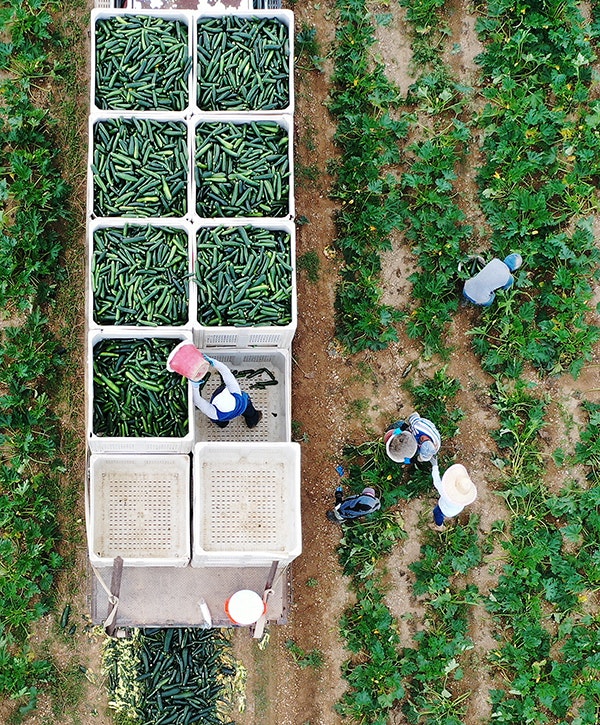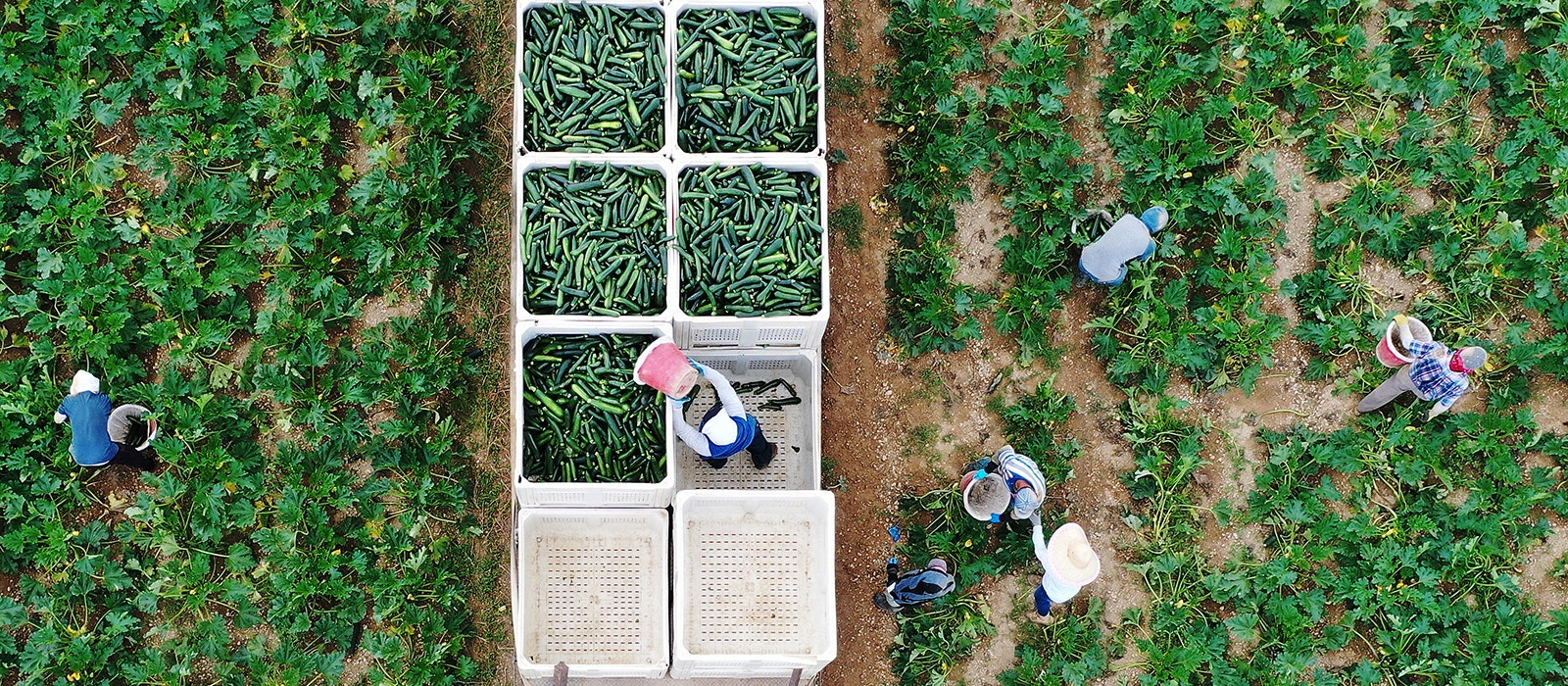For decades, immigrant farmworkers have helped feed America. But the agriculture industry faces a chronic labor shortage that has been exacerbated by the COVID-19 pandemic, and the conditions for and rights of farmworkers and their families must be improved. The critical importance of farmworkers, including those who are undocumented, has never been clearer. Modernizing the temporary visa program, and establishing a pathway to citizenship for long-term undocumented agricultural workers, is urgently needed to protect farmworkers and their families and ensure the future of America’s essential agriculture industry.
Immigrant Farmworkers and America's Food Production: 5 Things to Know


An estimated 73% of agriculture workers today were born outside of the United StatesEconomic Research Service - USDA
1| Farmworkers are essential workers - and most are immigrants
Immigrant farmworkers make up an estimated 73% of agriculture workers in the United States. Farm labor is absolutely essential work that puts food on our tables across the country, powers the economy and supports our communities, from dairy farms in Wisconsin to strawberry fields in Florida and apple orchards in Washington. All together, food and agriculture sector is a $1.053 trillion industry.1
Every state is involved in food production, but California, Iowa, Texas, Nebraska, and Minnesota make up more than one-third of total U.S. agricultural-output value. While some sectors like livestock production are scattered across the country, others are concentrated in certain regions, such as lettuce grown in Arizona or poultry farming in southeastern states like Georgia and Alabama.2
Agricultural work requires great skill and is relentless, exhausting, and can be extremely dangerous. All across the country, farmworkers spend extremely long hours harvesting crops in all types of weather while risking injury or illness from heavy equipment or pesticide exposure. In recent years, workers in states like California and Oregon have also faced wildfires and record heat waves, in addition to the threat of COVID-19.
Underscoring the critical importance of farmworkers, the Department of Homeland Security has deemed the food and agriculture sector as “critical infrastructure” during the pandemic. They deserve protections — not just the label "essential."
56% of California farmers reported being unable to find all the workers they needed over the last five years.California Farm Bureau Federation
2| Even before COVID-19 struck, America's farms faced a chronic labor shortage crisis
The American Farm Bureau Federation estimates that, in total, U.S. agriculture needs 1.5 to 2 million hired workers each year. Farmers have been struggling to fill these positions; in 2019, 56% of California farmers reported being unable to find all the workers they needed over the last five years.
This is partly because, even when wages and benefits are increased, there are still not enough U.S. citizens applying. The current agricultural workforce is also aging, requiring younger workers to replace them. Immigrants have filled these shortfalls in the workforce for decades, but in recent years, fewer immigrants are coming to the U.S. to work in agriculture, a result of current U.S. immigration policy and rising incomes in Mexico.
The labor shortage puts American agriculture at a competitive disadvantage. American growers’ inability to find dependable sources of labor is a major reason for the significant increase in the amount of fresh fruit and vegetables that are imported into the U.S, costing billions in sales and tens of thousands of jobs. Without workers, crops wither in the fields, contributing to food waste and millions of dollars in lost production.
In 2020, this chronic labor shortage was further exacerbated by the COVID-19 pandemic, which forced employers to keep workers at home and restricted access to foreign-born workers that farmers had been planning to employ.
3| Legalizing the undocumented workforce is an economic and moral imperative
Undocumented farm workers make up approximately 50% of the farm labor workforce. Without their hard work, millions of pounds of food would otherwise go unharvested. While these workers pay taxes and contribute to the economy, they are not protected by U.S. labor laws, and they live every day under the threat of arrest and family separation – all while working in extremely difficult conditions.
Despite lacking a legal immigration status, these workers and their families have lived in the United States for a long time. In general, the majority of undocumented immigrants have lived in the U.S. for more than ten years.
Likewise, the average farmworker has worked for their current farm employer for seven years, and more than 80% of hired farmworkers work at a single location within 75 miles of their home.
Relying on large numbers of undocumented individuals to fuel an industry is bad policy for workers and employers alike. But forcing them to leave would be even more devastating to our food supply, and fundamentally unfair, given what they’ve contributed. For example, the dairy industry estimates that retail milk prices would nearly double if farmers lost their foreign-born workers. Overall, agricultural output would fall by $30 to $60 billion.
Above all, the United States has a moral imperative to find a solution for undocumented families who have called this country home for so long, who have contributed greatly with little recognition, and who have more than earned their place in the American story.
In 2019, about 258,000 immigrant workers were granted temporary H-2A visas...but less than 4% of the total number of workers that are needed for food production.U.S. Department of Labor
4| The temporary H-2A visa program is important, but it is not enough
The H-2A Temporary Agricultural Worker Program is the primary way in which immigrant workers can legally perform short-term farm labor in the U.S. U.S. farmers can sponsor workers for a temporary employment visa if sufficient numbers of domestic workers are not available.
In 2019, about 258,000 immigrant workers were granted temporary H-2A visas, up from 48,000 positions certified in 2005, but less than 4% of the total number of workers that are needed for food production. Florida, Georgia, Washington, California and North Carolina were the top five states where the most H-2A workers were employed.
While the current H-2A program helps address labor shortages, more needs to be done to ensure farmworkers have access to basic rights, and protections from persistently low wages, overcrowded or unsafe housing conditions, and lack of access to health insurance.3
Additionally, farmers say utilizing the H-2A system is an expensive, slow process. On average, workers arrive to pick crops 22 days late. Farmers in year-round sectors like dairy or pork production cannot even participate because visas are only available for seasonal workers.
If farmers lost their foreign-born workers...American Farm Bureau Federation
agricultural output would fall by $30 to $60 billion.
5| Americans would benefit enormously from a stable agricultural workforce.
The nonpartisan Congressional Budget Office (CBO) has found that providing legal status to current undocumented workers would have a net positive effect on the federal budget, increasing tax revenues. The CBO has also found that legalizing the undocumented population would boost economic output and increase employment for U.S.-born workers.
Additionally, stabilizing the workforce would help U.S. farmers stay open for business, keepings jobs available for U.S. workers and pushing back on increasing food and production costs driven by the shortages.
Congress should allow undocumented farmworkers who have been present in the U.S. to adjust to a legal status. This would allow farmers to maintain their current workforce legally, while also allowing undocumented immigrants to come out of the shadows, earn a fair wage, be better protected from exploitation and abuse, and fully participate in the communities they have called home for years.4
Get in touch with us:
Andrew Moriarty
Deputy Director of Federal Policy
Notes
- As the United States Department of Agriculture (USDA) Economic Research Service explains, “Agriculture, food, and related industries contributed $1.053 trillion to U.S. gross domestic product (GDP) in 2017, a 5.4-percent share. The output of America’s farms contributed $132.8 billion of this sum—about 1 percent of GDP. The overall contribution of the agriculture sector to GDP is larger than this because sectors related to agriculture—forestry, fishing, and related activities; food, beverages, and tobacco products; textiles, apparel, and leather products; food and beverage stores; and food service, eating and drinking places—rely on agricultural inputs in order to contribute added value to the economy.”
- While some sectors of agriculture have turned to increased mechanization to try to address labor shortages, others cannot; for example, berries and other fresh produce be picked by hand to ensure their quality, and many dairy farmers can’t absorb the cost of switching to robotic milking machines. And because many workers eventually move on to other sectors, farmers are virtually always in need of new hires.
- The legal status of H-2A workers is also temporary and subject to an employer's sponsorship. While the visa can be re-approved annually for up to three years, then the worker must leave the U.S. for at least three months before applying to receive a H-2A visa again. No matter how many years a worker returns, there is no path to citizenship or permanent legal status for the worker or his or their family - despite the reality that many immigrant workers have been working on the same farm for years, sometimes year-round.
- With this reality in mind, farmers and farmworker advocates joined together to push for legislation to establish a legal, long-term workforce. In December 2019, the full House of Representatives passed the bipartisan Farm Workforce Modernization Act (H.R. 5038). The bill would modernize the H-2A program, require agriculture employers to authorize workers through an updated “E-Verify” process, and create a pathway to citizenship for current unauthorized agriculture workers. While H.R. 5038 marks the first time the House has approved agriculture-related immigration legislation since 1986, this model legislation has not received a vote in the Senate.
Tell the world; share this article via...
Read related articles:
Get Involved
We need your help to move America forward. Learn what you can do.